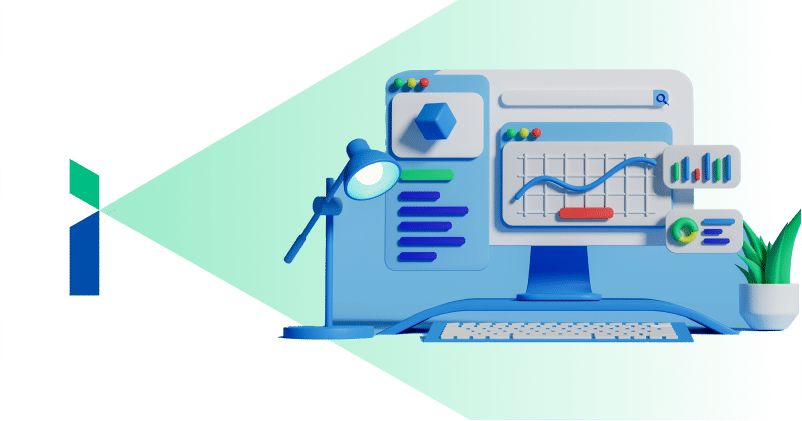When we talk about Financial Data Analysis, we’re essentially delving into the heart of Business Intelligence (BI) and Enterprise Performance Management (EPM). It’s all about taking a deep dive into financial data, sifting through numbers, and patterns. What emerges from this deep dive is a comprehensive picture of where an organization stands financially. And with this clarity, businesses can make decisions that aren’t just informed but transformative for their overall performance.
What’s the Goal Here?
Risk Management: Imagine navigating a ship through stormy seas. Data serves as our guiding star, helping us spot potential financial icebergs and charting a course to steer clear of them.
Evaluating Our Past: It’s akin to reflecting on a year gone by. We sift through past actions, celebrate our wins, learn from our setbacks, and gear up for future challenges.
Gazing into the Future: By studying historical data, it’s almost as if we have a magic mirror. It enables us to forecast, create strategies, and make informed decisions that set us up for success.
Why Financial Data Analysis (FDA) is revolutionary
Financial data isn’t just numbers on a screen; it’s the bedrock upon which strategic decisions are built. Whether it’s anticipating the highs and lows in sales, identifying our star clients, or gauging how well a product is doing, decisions rooted in data are the gold standard.
The financial world is ever-evolving, and with it comes tools that redefine precision and foresight. Consider real-time dashboards, for instance. They aren’t just fancy tech; they’re revolutionizing how we operate. Offering a real-time snapshot of our financial well-being, these tools empower us to act promptly, ensuring we’re always on the path to growth and success.
The Role of Financial Data Analysis in Finance
The world of finance is intricate, vast, and ever-evolving. At its core, driving this dynamism, is Financial Data Analysis (FDA). When we talk about the financial industry, be it banking, investment, or insurance, FDA is the silent force ensuring everything runs smoothly.
Banking: Consider the vast number of transactions processed by banks daily. Financial Data Analysis (FDA) meticulously monitors each one, primarily for fraud detection and operational risk assessment. It’s this robust system that assures both banks and their clients of the security of their transactions.
Investment Banking: In the high-stakes realm of investment banking, where risk and reward constantly vie for dominance, Financial Data Analysis (FDA) serves as a strategic advisor. Its role is to ensure that investment choices aren’t solely about immediate returns but are sustainable for the future.
Insurance: Ponder upon the insurance premiums you pay or the myriad products available in the market. Behind these decisions lies FDA’s predictive analytics, which understands historical patterns and forecasts future trends, allowing insurance companies to tailor their offerings effectively.
Beyond Raw Data: Gleaning Actionable Insights The utility of FDA isn’t limited to number crunching. It produces actionable insights. For example, when a bank offers you a specific financial product, it’s often due to FDA insights identifying potential needs of their clientele. In the sphere of credit risk, FDA plays a pivotal role in ensuring that potential loan risks are systematically evaluated and managed.
Real-world Impact of FDA: Taking the discussion to tangible examples, let’s examine Walmart’s Global Retail Division. Through adept utilization of Financial Data Analysis FDA, they strategically analyzed sales patterns, leading to a significant 25% reduction in inventory costs and an increase in sales by 15%. On another note, J.P. Morgan & Chase employed FDA to discern the financial behaviors of millions, allowing them not only to determine credit-worthiness but also to gain broader economic perspectives.
Benefits of Financial Data Analysis
Financial institutions are increasingly leveraging financial data analysis to navigate the intricacies of the financial landscape. The following sections delve into the substantial advantages of this practice, illustrating its impact on risk management, investment strategies, and customer experience, alongside showcasing its potential for cost savings and heightened profitability.
Real-Time Analyses: Financial data analysis facilitates real-time analysis, allowing institutions to generate forecasts, reports, and data models swiftly. This immediacy in decision-making is crucial for staying competitive and capitalizing on growth opportunities.
Better Debt Management: Effective debt management is paramount for long-term sustainability. For instance, the United Nations has invested in optimizing its data management to hedge against the global debt crisis. The financial analysis aids in accurately tracking the ratio between current assets and liabilities, which is crucial for planning both short-term and long-term debt management strategies.
Optimizing Financial Performance and Compliance: Financial institutions can refine processes through data analysis, ensuring compliance with financial reporting standards like GAAP and IFRS. This optimisation consequently boosts efficiency, accuracy, and speed over time.
Risk Mitigation: Financial analysis helps identify and rectify process inefficiencies, errors, and delays, preventing potential crises. For example, predictive analytics can anticipate market changes, enabling proactive contingency planning.
Investment Strategies: Data-driven insights are pivotal for formulating strategically sound investment decisions, which are crucial for navigating volatile market conditions.
Customer Experience: Real-time data sharing facilitated by financial data analysis improves communication and collaboration, aligning operations with customer expectations and market demands. For creditors and investors, transparency in financial data epitomized by custom dashboards displaying key financial ratios is highly appealing.
Cost Savings and Increased Profitability: By harnessing data-driven insights, financial institutions can identify areas for process optimisation, leading to significant cost savings. Moreover, prudent investment and business process management initiatives spurred by financial analysis enhance profitability.
Cash Flow Management: Enhanced cash flow management is a notable benefit of financial data analysis. For instance, a 2020 study by the International Labour Organisation pinpointed cash flow management as a significant challenge during the COVID-19 pandemic. Through thorough analysis, institutions can better understand their revenue streams and liabilities, enabling robust strategies to mitigate unpleasant financial surprises.
The Future of Financial Data Analysis
The financial landscape is buzzing with change, and guess what’s steering the ship? Financial Data Analysis (FDA). With technology redefining the way we view data, let’s sit down and unpack where FDA is headed and why you should be paying close attention.
Welcoming AI into the Decision-Making Fold: It’s impressive how much trust AI has garnered in the financial world. A KPMG report threw a spotlight on this, revealing that 34% of top-tier CEOs are ready to bank on AI-driven data, sometimes even over their gut instincts. With 70% of organizations adapting AI, it’s clear they’re positive about profitable returns.
The Power of Big Data: Migrating to cloud solutions and utilizing big data isn’t just the trend; it’s a necessity. It’s all about foreseeing risks and sharpening predictions, and according to that same KPMG report, this shift is essential for the future.
Automation and Beyond: When we talk about a nimble future, automating forecasts is where the action is. Leading players are on a mission to enhance their insights and stay agile. Imagine a world where scenario planning and “What-if” analysis help businesses pivot seamlessly with the ever-changing market. That’s the goal.
Collaborate, Share, and Advise: Financial departments aren’t just about crunching numbers anymore. They’re morphing into global knowledge-sharing hubs, playing pivotal roles in cross-functional deliveries and strategic business advisories. The mantra these days? Engage, plan, deliver, and build. It’s about finance teams stepping up as strategic advisors, leading enterprise-wide planning, and dishing out crucial analytics.
Embracing Tomorrow’s Tech, Today: Cloud computing. Big data. These aren’t just industry jargon; they’re cornerstones of tomorrow’s finance. Integrating these technologies not only optimizes financial processes but also promotes transparency, precision, and swift adaptability in financial reporting. For any organization hoping to scale and evolve, understanding and implementing these innovations is paramount.
Starting the Journey Towards Enhanced FDA
As suggested in the report, the initiation of enhanced financial data analysis requires aligning the DA&I vision with the overall Finance vision and preparing to shift to an analytics-driven organization. The insights highlight the importance of delving deeper into financial data analysis and strategically leveraging AI, big data, and cloud computing to effectively navigate the evolving financial landscape and foster data-centric, precise decision-making.
Conclusion
The discourse traverses the transformative avenue of Financial Data Analysis (FDA), beginning with its definition, objectives, and significance in strategic decision-making. It exemplifies the FDA’s real-world impact, referencing notable entities like Walmart and J.P. Morgan, showcasing substantial cost management and revenue generation.
Transitioning to modern reporting advancements, the narrative underscores real-time dashboards for better fiscal decisions. It explores the FDA’s diverse applications across financial sectors, emphasizing its role in fraud detection, risk modeling, and predictive analytics.
Conclusively, the discussion forecasts the future of the FDA, highlighting AI and Big Data Processing as impending technological advancements. It advocates for the strategic integration of such technologies, encapsulating the essence of the FDA in fostering data-driven, precise decision-making within the contemporary financial landscape.
About Perfios:
Perfios Software Solutions is India’s largest SaaS-based B2B fintech software company enabling 900+ FIs to take informed decisions in real-time. Headquartered in Bangalore, India, Perfios specializes in real-time credit decisioning, analytics, onboarding automation, due diligence, monitoring, litigation automation, and more.
Perfios’ core data platform has been built to aggregate and analyze both structured and unstructured data and provide vertical solutions combining both consented and public data for the BFSI space catering to their stringent Scale Performance, Security, and other SLA requirements.
You can write to us @ connect@perfios.com
For more information on our solutions, contact us @ https://solutions.perfios.com/request-for-demo














